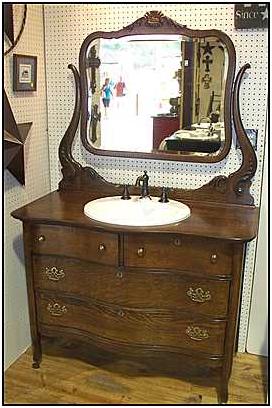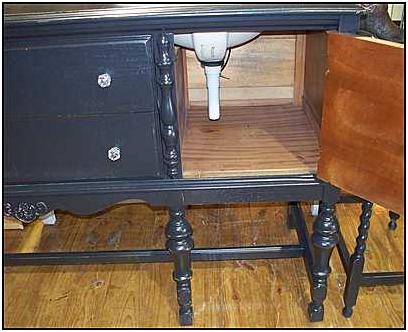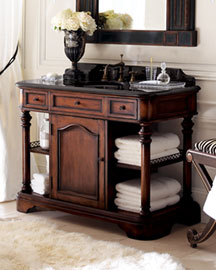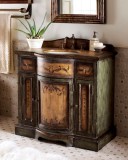By Scott Dostal
Using an antique bathroom vanity or converting a piece of antique furniture into a bathroom vanity is a very popular design trend. However, there are challenges associated with using antique furniture to create a bathroom vanity, as well as using an antique and adapting to modern plumbing.
There is a significant difference between using an antique piece of furniture and using a modern bathroom vanity made in the
style of antique furniture. The modern “reproductions” are designed for modern plumbing. In addition, they typically are made with wood that has been treated and sealed to prevent damage from steam and moisture. In most cases, careful measurements allow homeowners to choose a style, have it delivered, and install it by simply making the appropriate connections to pipes.
Working with antique furniture presents certain challenges. Some homeowners have the required skills to convert an antique into a bathroom vanity. Others will want to shop for the perfect piece of furniture and have a skilled cabinetmaker do the work of converting it into a vanity. A third alternative is to buy a converted antique vanity from one of the dealers who specialize in converting antique furniture for this purpose.
Bathroom vanities often are made from antique sideboards, servers, hutches, dressers, washstands, chests, trestle tables, sewing cabinets, or Victrola cabinets. All of these furniture items can be converted to either one- or two-sink vanities, depending upon the width of the item.
Several decisions must be made before the conversion can begin:
1. Perhaps most important, is the question if the antique of sufficient value that it should not be damaged or altered. In this case, the antique might not be the best choice for use as a bathroom vanity because the finish and, potentially, the wood will be damaged by moisture and steam.
2. Will you use the antique in its current condition, or will you refinish or paint it?
3. Are you willing to cut holes in the surface, the back, and the bottom of the antique? If it is a taller piece (such as a server or sideboard), will you remove legs to make it the correct height?
The challenges of using an antique bathroom vanity are these:
· You must choose the antique carefully to ensure a correct fit in the bathroom and with the current placement of plumbing. Although you can have pipes moved, doing so will substantially increase the cost of your bathroom remodel.
· Once you decide whether you will use the antique in its current condition, refinish it, or paint it, you will need to waterproof the antique on both the inside and the outside. Without waterproofing, the wood will absorb water and steam, causing warping and, possibly, mildew.
· Next, you must decide what type of sink you will use. A vessel sink might require the least alteration of the antique, but it might also be too high, if the antique is a taller piece of furniture.
·
You will then need to decide whether you will cut a hole in the surface of the antique for the sink, or you will remove the surface and replace it with a “countertop” material, such as marble, granite, etc.
· The next step will be to modify the cabinet(s) and drawer(s) to accommodate the correct location of pipes and install the pipes, with connections to the sink you have chosen.
· You will then be able to complete the modifications of the antique to enclose drawers and cabinets for your use. You might also decide to install dividers or organizational inserts to make the vanity more functional.
· Finally, install the faucets and other fixtures you have chosen to complete your décor.
Although there are challenges in using an antique as a bathroom vanity, you can overcome them. These challenges will be within the skills of some homeowners. Others will need to engage the services of an expert cabinetmaker. Whether you do the work or you hire someone, the result will be a unique bathroom that is exactly what you want.
Happy remodeling!








